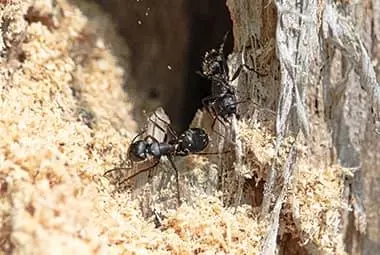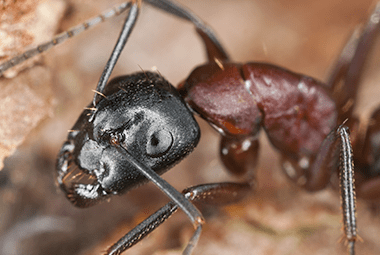In our Knoxville service area, carpenter ants can be a significant threat. These ants can damage man-made structures as they create places to establish nests. If they chew their way into your Knoxville home, there are three important points you should consider.
1.Carpenter ants aren’t always easy to detect.
This is the big one. If you know a little about carpenter ants, you might think you’ll be able to detect them and stop them before they damage your home. This isn’t always the case. The ways carpenter ants reveal themselves can sometimes go unnoticed:
- Worker ants. You might think that you’ll see big, black ants crawling around inside your home when these ants get in. Sadly, this is rarely the case. Carpenter ants can find a lot more to eat on the outside of your Knoxville home than they can on the inside. They don’t need to raid your cabinets to get a bite to eat. You may, however, see a random scout every once in a while. If you do, be aware that one scout ant may be the only warning sign you get.
- Ants outside. You might think that you’re going to see lots of busy little ants around your Knoxville home when carpenter ants get in. Unfortunately, carpenter ants are mostly nocturnal. They’ll be busy while you’re sleeping.
- Sawdust. If you know that carpenter ants don’t eat wood, you might think that you’ll see sawdust piles when these ants get into your home. Keep in mind that the nocturnal nature of carpenter ants causes them to get into dark places around and inside your home. These are usually areas that are hard to get into.
- Winged ants. You may think you’ll see flying ants if you have an infestation. The problem with this warning sign is that swarms don’t last for more than 30 minutes and sometimes flying ants take to the air and move right into the next-door neighbor’s yard.
2. Carpenter ant damage can cause a lot of problems.
Over time, carpenter ants can do a lot of damage. As they weaken timbers, it can put stress on the structure of your Knoxville home and lead to serious damage.
3. Carpenter ants are difficult to control.
Have you ever tried to eliminate ant colonies? It’s hard. And when you’re unsuccessful, it is difficult to know it. This is something you don’t want to do with carpenter ants. The last thing you need is to have these ants continuing to do damage to your home right under your nose.
For ant control in Knoxville, reach out to Russell’s Pest Control. We have the experience and knowledge to help you protect your property and keep ants out.

